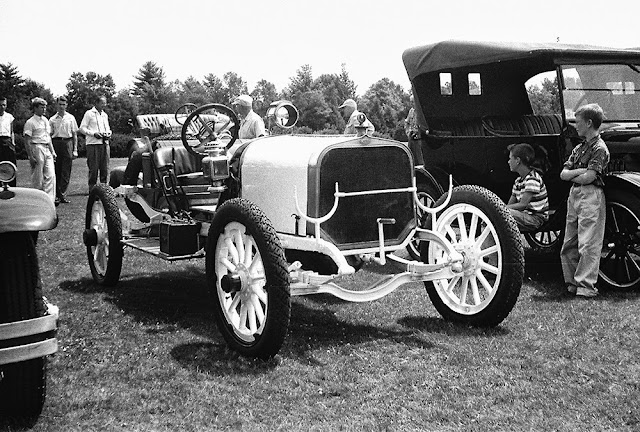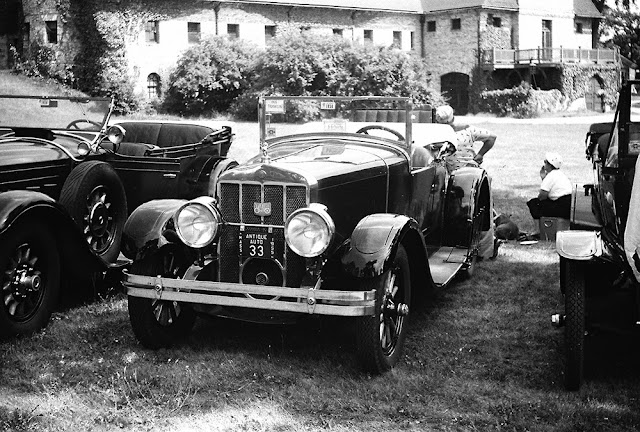 |
| George Whittell's 1927 Rolls-Royce PI - S425FL (from the author's collection) |
I had the pleasure of seeing this car recently, and I have to admit, I was really taken by it. The Springfield built cars of Rolls-Royce of America are some of my favorite cars from the Classic era. This car (S 425 FL) is a very early Springfield Phantom I (1927) and wears the step plate of a somewhat obscure San Francisco body company. I'm not sure I'd describe the body as beautiful, but in person it's quite striking and it's rare to see a Rolls-Royce bodied in San Francisco. Needless to say, I had to find out the story behind the car.
Well, it appears I'm not the first person to be curious about this car as I found an article from August of 1987 written about the car in Special Interest Autos. The Rolls-Royce's history is facinating and starts with George Whittell Jr. Mr. Whittell, the only child of San Francisco real estate and banking wealth (he was actually a twin, but his brother died at the age of three), was a notorious playboy with a passion for cars, boats, and women. Many automobile enthusiasts will know him as one of the Duesenberg brothers greatest fans, purchasing six Model J's over his lifetime. One of these cars, nick-named the Whittell Coupe, was sold by Goodings & Co in 2011 for $10.34 million.
It turns out George liked Rolls-Royce's as well, and according to an interview by Automobile Quarterly (Vol. 26, No. 1) of Francis Kuboski (Whittell's mechanic), in August of 1927 Whittell accepted delivery of a Rolls-Royce Phantom I chassis from Springfield. According to Kuboski, Whittell hired a coachbuilder from England to come over and design a body to be built at Burt Larkins shop on Geary Street in San Francisco. Further, according to Kuboski, after the car was delivered to Whittell, he parked it and drove little. This conflicts slightly with the SIA article which stated that Whittell was sometimes seen in the car diving about with one of his pet lions. Regardless of which story you believe, the car saw minimal use and was sold to Douglas Duggins - a neighbor of Whittells in Woodside, CA. In 1948 the car passed to Lee Sturla, who stored the car for over 40 years there in the San Francisco area. I'm not sure when or from whom the current owner acquired the car. As with all Phantom I's, this car has a 7 liter, 6-cylinder engine and appears to retain its original paint and interior.
Larkins & Co. is described within Mark Theobald's wonderful website,
coachbuilt.com. The company was started just after the civil war by an Irish immigrant named William Larkins. By the time the company entered the automobile business it was run by William Bernard Larkins, but he died in 1913 and his son, William Burton Larkins (known as Burt) took over. After the great fire of 1906, the company relocated three times, finally settling in the former Geary Street car barns (originally housing steetcars or trollies). The company was primarily an auto body painter and repair shop. However, they built custom bodies for the luxury dealers in San Francisco and were also known for what would come to to be called the "California Top" (called the Larkins Top by the company). I had the good fortune to see one of these tops fitted to a Pierce-Arrow recently (it being sold new in San Francisco). Larkin & Co. would survive until the 1950's, when the next generation transformed it into the Larkins Brothers Tire Shops.
Today it is thought that there are less than a handful of surviving Larkins & Co. bodied cars.
 |
| 1927 Rolls-Royce PI with Larkins & Co. body (from the author's collection) |
 |
| (from the author's collection) |
 |
| I believe this is a Larkins Top on a Model 48 Pierce-Arrow (from the author's collection) |






























